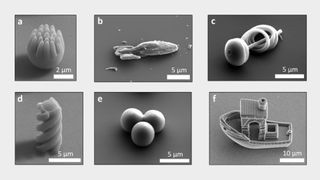This unfeasibly tiny 3D printed Star Trek ship can move under its own power
Behold the power of 3D micro-printing technology and catalytic propulsion.

This unfeasibly tiny 3D printed, 15 micrometer model of the USS Voyager—well of an Intrepid-class starship (we can't quite make out the designation)—can actually move under its own power. Though warp speed is admittedly still just out of reach.
As part of research around artificial microswimmers (more on those in a second), a team of researchers at Leiden University have been testing their microscopic 3D printer (via Gizmodo) with a host of exotic forms. Where previously they were limited to simple spherical shapes, researchers are now able to print helixes, tugboats, and even the starship Voyager, as well as weird lollypop looking contraptions.
Seriously, what is that thing in the top right?

If you're wondering what artificial microswimmers are, essentially they're microscopic objects that are able to move through liquids. These 3D printed, synthetic "colloidal particles" (solid objects suspended in liquid) have no moving parts, instead they propel themselves through liquid by way of chemical reaction—platinum that reacts with hydrogen peroxide. No tiny impulse engines here.
Among the test objects stands a 30-micrometer "Benchy the tugboat", one of the best known 3D benchmark tester objects. With a lot of complex geometry, it helps to identify flaws with printers that may have otherwise been overlooked.
One researcher, Daniela Kraft, explains “3D Benchy is a structure that has been designed to test macroscopic 3D printers because it has several challenging features, and it was natural to also try it at the micrometer scale."
Kraft also admits that "making a swimming micrometer-sized boat is fun.” And, although it may look like the team is just messing around with their novel, dinky 3D printer, their research will eventually contribute to understanding of biological microswimmers such as sperm, bacteria and white blood cells.
PC Gamer Newsletter
Sign up to get the best content of the week, and great gaming deals, as picked by the editors.

Black Friday 2020 deals: the place to go for the all the best early Black Friday bargains.
According to the Soft Matter journal entry, their conclusion, thus far, has been that "3D microprinting overcomes current limitations in the fabrication of active microswimmers with complex shapes and controlled patch location."
So, basically, the amazing scientific discovery that came from this exploit is that it's totally possible to micro 3D print funky objects, so researchers don't have to stare at tiny balls all day. Still, check out that space ship.

Screw sports, Katie would rather watch Intel, AMD and Nvidia go at it. Having been obsessed with computers and graphics for three long decades, she took Game Art and Design up to Masters level at uni, and has been demystifying tech and science—rather sarcastically—for three years since. She can be found admiring AI advancements, scrambling for scintillating Raspberry Pi projects, preaching cybersecurity awareness, sighing over semiconductors, and gawping at the latest GPU upgrades. She's been heading the PCG Steam Deck content hike, while waiting patiently for her chance to upload her consciousness into the cloud.
Most Popular




